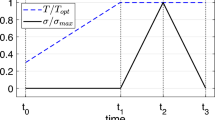Abstract
Shape memory polymer (SMP) has been intensely studied for various industrial applications, such as biomedical and aerospace field due to its unique thermomechanical behavior (i.e., shape recovery). However, the researches of reversible plasticity shape memory (RPSM) polymers are insufficient. Here, we investigated the thermomechanical behavior of polyurethane-based shape memory polymer under glass transition temperature. We analyzed effect of strain rate on yield stress and elongation to take into account the application range of the RPSM polymers and made RPSM polymer material model which depends on strain rates by using numerical simulation. To confirm the application range of the RPSM polymers, we applied this material model to automobile bumper and analyzed the possibility of using the RPSM polymers to automobile bumpers through low-speed collision simulation. It was confirmed that the failure strain of the RPSM polymers based bumpers was ten times higher than that of conventional bumpers. It was expected that the application field of the RPSM polymers will be expanded by applying the strain rate dependent RPSM polymer model to various fields.







Similar content being viewed by others
References
L.-T.T. Nguyen, T.T. Truong, H.T. Nguyen, L. Le, V.Q. Nguyen, T. Van Le, A.T. Luu, Healable shape memory (thio) urethane thermosets. Polym. Chem. 6, 3143–3154 (2015)
N. García-Huete, J.M. Laza, J.M. Cuevas, B. Gonzalo, J.L. Vilas, L.M. León, Shape memory effect for recovering surface damages on polymer substrates. J. Polym. Res. 21, 481 (2014)
E.D. Rodriguez, X. Luo, P.T. Mather, Linear/network poly (ε-caprolactone) blends exhibiting shape memory assisted self-healing (SMASH). ACS Appl. Mater. Interfaces 3, 152–161 (2011)
T. Xie, Recent advances in polymer shape memory. Polymer 52, 4985–5000 (2011)
R. Abishera, R. Velmurugan, K.N. Gopal, Reversible plasticity shape memory effect in carbon nanotubes reinforced epoxy nanocomposites. Compos. Sci. Technol. 137, 148–158 (2016)
T. Lin, Z. Tang, B. Guo, New design strategy for reversible plasticity shape memory polymers with deformable glassy aggregates. ACS Appl. Mater. Interfaces 6, 21060–21068 (2014)
X. Zhang, Z. Tang, B. Guo, Reversible plasticity shape memory polymers: key factors and applications. J. Polym. Sci. B Polym. Phys. 54, 1295–1299 (2016)
J.J. Song, H.H. Chang, H.E. Naguib, Biocompatible shape memory polymer actuators with high force capabilities. Eur. Polym. J. 67, 186–198 (2015)
S. Gangireddy, M. Komarasamy, E.J. Faierson, R.S. Mishra, High strain rate mechanical behavior of Ti-6Al-4V octet lattice structures additively manufactured by selective laser melting (SLM). Mater. Sci. Eng. A 745, 231–239 (2019)
P. Moy, C.A. Gunnarsson, T. Weerasooriya, W. Chen, Stress-strain response of PMMA as a function of strain-rate and temperature. Dyn. Behav. Mater. 1, 125–133 (2011)
C.R. Siviour, J.L. Jordan, High strain rate mechanics of polymers: a review. J. Dyn. Behav. Mater. 2, 15–32 (2016)
W. Lee, H. Lee, J. Bae, D. Kim, Optimization of manufacturing process for exterior quality of commercial vehicle by multi-physics simulations. Multiscale Sci. Eng. 2, 114–126 (2020)
H.C. Lee, W. Lee, J.H. Moon, D. Kim, Geometric effect of grating-patterned electrode for high conversion efficiency of dye-sensitized solar cells. Multiscale Sci. Eng. 1, 161–166 (2019)
C. Liu, H. Qin, P.T. Mather, Review of progress in shape-memory polymers. J. Mater. Chem. 17, 1543–1558 (2007)
D. Gierczycka, D.S. Cronin, Occupant thorax response variations due to arm position and restraint systems in side impact crash scenarios. Accid. Anal. Prev. 106, 173–180 (2017)
Acknowledgements
This work was supported by the National Research Foundation of Korea (NRF) grant funded by the Korea government (MSIT) (No. 2020R1A2C2010986). This work has also been supported by the C1 Gas Refinery Program through the National Research Foundation of Korea (NRF) funded by the Ministry of Science and ICT (No. 2018M3D3A1A01055759).
Author information
Authors and Affiliations
Corresponding author
Additional information
Publisher’s note
Springer Nature remains neutral with regard to jurisdictional claims in published maps and institutional affiliations.
Rights and permissions
About this article
Cite this article
Kim, Y., Lim, Y., Cha, D.E. et al. Simulation of Reversible Plasticity Shape Memory Polymer with Designed Strain Rate Dependent Failure Model. Multiscale Sci. Eng. 3, 88–94 (2021). https://doi.org/10.1007/s42493-021-00061-w
Received:
Revised:
Accepted:
Published:
Issue Date:
DOI: https://doi.org/10.1007/s42493-021-00061-w




